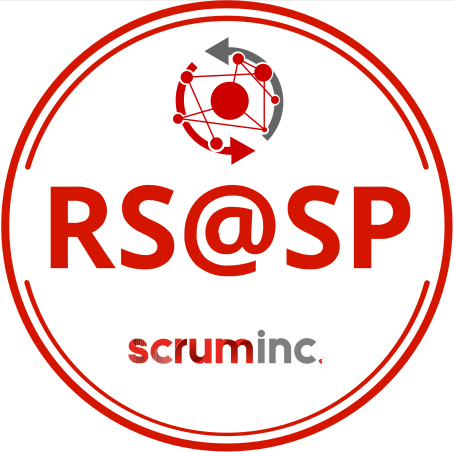
The Agile Organization
(and how Scrum@Scale can help)
Titel: Registered Scrum@Scale Practitioner™ (English)
Date: May 30-31, 2023, Online
Price: Price: EUR 1’900 + EUR 100 for the certification badge
BONUS: Jeff Sutherland will give us a visit and will be available for questions.
Scrum@Scale is not an agile “scaling method,” such as SAFe, LeSS, or Nexus. It is not a turnkey solution.
Scrum@Scale is rather a framework that raises questions. The answers to these questions look different from one organization to another. Just as organizations are different. Different industries, different products, different employees, different cultures, etc. The one-size-fits-all solution sold in a package with grandiose promises of course sells well. But they do not do much good, and in the long run, they can even cause harm.
Complex endeavors, as agility has already taught us, are solved by ensuring that all stakeholders have:
- the same vision
- make small steps towards that vision
Scrum@Scale supports this journey. It helps make one’s vision of one’s own agile organization more tangible; and it provides assistance with the recurring question, “What would be the most valuable next step?”
So even organizations that have started with, for example, SAFe or LeSS, can use Scrum@Scale to evolve. A method itself can never be the goal. A method is only a means to an end. The long-term goal is satisfied customers and employees – it’s a matter of philosophy as to which is the chicken and which is the egg.
A rolling stone gathers no moss. As an organization, one must constantly ask “What now?” Scrum@Scale with its 12 questions guides you through this.
One could say that SAFe and cohorts are instantiations of Scrum@Scale. Each of these methods provides its own answers to the questions that S@S raises. But each only one answer, and what if that one answer does not fit the organization?
The first scaling rule: Do not do it!
One of the basic principles of Scrum@Scale is to only “scale” where it is actually unavoidable. Scaling means coordination effort and often leads to massive friction losses. In Scrum@Scale, we therefore apply the principle of Minimal Viable Bureaucracy (MVB) in order to work as efficiently as possible.
In this course, participants will learn how to achieve this and what structures are needed to continuously work towards MVB. They will learn to continuously improve their own organization in small and valuable steps. The times of large-scale reorganizations are a thing of the past, most of us can confirm from our own experience that these do not work well or at all.
Registered Scrum@Scale Practioner

After the 2-day course and passing a written test, each participant is enrolled in the ‘International Registry of Agile Professionals™’ (unless explicitly declined) and can call themselves a ‘Registered Scrum@Scale Practitioner™ / RS@SP’.
However, the course offers much more. In addition to a fundamental understanding of what is essential when making an entire organization more agile, each participant will also create the well-known and often-copied ‘Heat Map’ for their organization during the course. For each of the 12 components of Scrum@Scale, one considers the extent to which they are relevant to their own company and what level of maturity they already have. This results in a ‘Change Backlog’ at the end of the course that clearly shows where the focus should be for the next steps of change.
The 12 Components
Scrum@Scale consists of 12 scaling components, also known as focal points, each of which is presented and explained in detail.

For example, the “Continuous Improvement Process” scaling component (top left). The questions for this are:
- What does my organization do to ensure that we are constantly improving?
- Do our structures even allow for this?
- Does our culture encourage all employees to think along and do they receive recognition for pointing out weaknesses?
- Is continuous improvement the responsibility of management, and if so, should it stay that way?
- Are our employees empowered to remove obstacles themselves, and if not, do they know who to turn to?
- Etc.
The self-assessment for each of these components ultimately leads to the aforementioned heat map.

During the course, the instructor will share insights from his rich experience working with organizations throughout Europe and North America. In addition, there will be several practical exercises that help to bring the learned concepts closer to the participants.
However, this should not be the end of the learning experience. Participants are encouraged to share their own reality, not just success stories but also failures, as one can often learn more from those than from situations that went as planned.
There is much to learn from one another, and this course aims to provide a platform for that. It inspires new experiments to improve one’s own organization and offers the opportunity to expand one’s network. It is not uncommon for participants to continue exchanging ideas long after the course has ended.
Content
These are the topics covered in the Scrum@Scale course:
- What is Scrum@Scale and how does it help organizations become more agile?
- The 12 scaling components in detail.
- Scaling the roles: Product Owner and Scrum Master (the “Cycles”).
- Scaling the events: Discussion on how to scale the “Planning”, “Review”, “Retrospective”, and “Daily” events.
- Scaling the artifacts: The integrated potentially shippable product increment - how to achieve it. Visions at different levels and how teams pull work (Lean Portfolio Management).
- Development of your own Heat Map (for each participant), the tangible result that provides clarity on what to focus on upon return to the workplace to start or revitalize the Agile transformation.
Course logistics
The two-day course is quite intensive. Therefore, it is essential for participants to prepare accordingly and have certain prior knowledge. A general understanding of agility and Scrum is required, and participants should have practical experience with Scrum. Experience with SAFe, LeSS, Nexus, etc. is advantageous. Participants must re-read the Scrum Guide (13 pages) and the Scrum@Scale Guide (20 pages) shortly before the course. Additional preparatory literature, amounting to approximately 1-2 hours, will be sent to participants before the course.
The course is held online.
Language of instruction: English
Materials (slides, etc.): English
Start time on both days: 9am CET
End time on both days: 5pm CET
One-hour lunch break and several short coffee breaks in between.
Exam
After the course, each participant who wants to take the test has one month to do so and pass it. The test is taken online on the participant’s own computer, which is why it is an “open book” test (all aids are allowed). At least 80% or 23 of the 30 questions must be answered correctly to pass.
More information about the test will be provided at the end of the course.
Course fee
The course fee is EUR 1,900 per person.
Included in this fee are:
- The course (2 days)
- Photo-journal after the course (all material shown by the course instructor, used otherwise or jointly developed by the participants)
The subsequent test (and the associated registration as RS@SP) is voluntary and costs an additional EUR 100 per person.
Course instructor
Klaus Bucka-Lassen is one of the most experienced course instructors in the field of Scrum. He has been working closely with Jeff Sutherland since 2010 and has conducted over 20 courses with the inventor of Scrum. That’s why Klaus is also one of only 17 Scrum Inc. Fellows worldwide. With a participant rating of 4.84 out of 5, Klaus is also one of the best-rated instructors.
Participant feedback:
- “The course was VERY good! It stands out significantly from other courses.”
- “Klaus is very competent, very practical with a lot of experience.”
- “Pedagogically well-structured”
- “Great course, trainer competent in all aspects!”
- “A lot of ‘best practices’ that we can really use”
- “The content was conveyed very understandably, I have the impression that I can/want to apply the course content directly in my daily work”
- “Great expertise; A lot of experience”
- “The trainer is very familiar with the subject matter and can explain it in an understandable way. In addition, Klaus responded very professionally to questions.”
- “Great course, very entertaining, intensive, the day flew by.”
- “That was truly a fantastic course.”
- “I have never learned so much in two days.”
Additional Information
These are some links with further information about Scrum@Scale:
- Official Scrum@Scale website with lots of useful information about S@S.
- Henrik Kniberg presents Spotify as a Scrum@Scale case study [2 min. YouTube Video].
- Renee Tsielepi explains Scrum@Scale in a nutshell [15 min. YouTube Video].
- Jeff Sutherland explains Scrum@Scale in one minute [1 min. YouTube Video].
- Klaus Bucka-Lassen presents his own Scrum@Scale case study from Canada, which will also be used as an example during the course [7 min. YouTube video].
